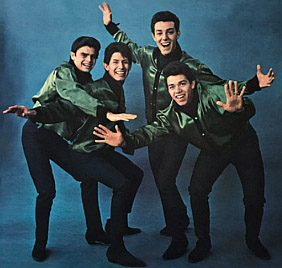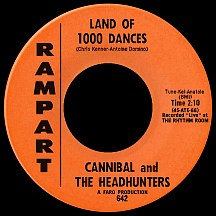CANNIBAL AND THE
HEADHUNTERS
Land of 1000 Dances
Let's get right into the answer to the burning question: Why did they call themselves Cannibal and the Headhunters? One story places the quartet at a performance by The Salas Brothers hosted by top 40 station KRLA in Los Angeles. Noticing Francisco Garcia's nickname was "Cannibal," Rudy Salas suggested he use it professionally (young Frankie had apparently gotten into a fight at school and bit the other guy's ear, resulting in a nickname that he couldn't shake). 1110 DJ Dick Moreland mentioned "Headhunters" as a logical fit and the rest is history. But there are acquaintances who have said that as a child, Frankie was called "Li'l Cannibal" after older brother Art "Big Cannibal" Garcia. Others believe the group's manager, Billy Cardenas, had come up with the unusual name. A peculiar theory circulated at the time of their album release: the lead singer was billed on the back cover as Cannibal "Frankie" Garcia, which was also used on concert posters, suggesting Cannibal had been on his birth certificate and the Frankie part came later. But of course it was the other way around. So there's no definitve answer; at any rate, it's an attention-getter that's gotta be one of the weirdest names of all '60s groups.
Robert "Rabbit" Jaramillo and his brother Joe "Yo-Yo" Jaramillo formed the act with Richard "Scar" Lopez, whose nickname came after an accident at a Boys' Club gym a few years earlier that required him to get stitches in his forehead. They called themselves Bobby and the Classics and had a preference for vocal group harmony, sometimes singing in public outside a nearby burger joint. Frankie (had he really sung lead in Cardenas's group The Rhythm Playboys?) stopped by the brothers' East L.A. home one day while they were practicing, demonstrated an above-average vocal ability, and soon became the lead singer. Cardenas, always on the lookout for young Latino acts, arranged an audition with Eddie Davis (the owner of Faro Records and its sister label Rampart), who was willing to give them a shot.
"Land of 1000 Dances," written and recorded by New Orleans-based singer-songwriter Chris Kenner (with a contribution from Fats Domino), had first appeared in the summer of 1963. A favorite of East L.A. bands, nearly everyone was doing a version of the song at live shows during 1964; at some point a catchy 'na-na-na-na-na' refrain, that wasn't part of the original, found its way into these East Side renditions. A six-minute version recorded at a show at East Los Angeles College by Thee Midniters, another Cardenas client signed to the Chattahoochee label, was released in two parts; the A side had started picking up airplay in far-flung cities near the end of the year when Cannibal and the Headhunters put out their version. In January, local stations KFWB and KRLA, instead of choosing between the two, played them both and within a month they were sharing space in KRLA's top ten. At the end of February, they lip-synced their rising hit on Dick Clark's American Bandstand.

Nationally, Thee Midniters' version ran out of steam first, while the Headhunters record (produced by music biz everyman Perry Botkin, Jr.) worked its way to a top 30 spot on the Billboard charts in April '65. As the hit was at its height, Cannibal's quartet went to New York for the first time to appear in a big concert organized by Murray "The K" Kaufman at the Brooklyn Fox, side-by-side with their Motown heroes The Miracles, The Temptations, Four Tops, Marvin Gaye, Martha and the Vandellas and others. That spring they opened for red-hot acts The Rolling Stones, The Beach Boys and The Righteous Brothers. Murray the K invited them back for more shows in Brooklyn throughout the year. A follow-up Rampart single, "Nau Ninny Nau," had the energy of its predecessor but sounded too similar and barely scratched the national charts in June.
Turns out Paul McCartney caught the Hullabaloo episode and wanted them for The Beatles' upcoming U.S. Tour, kicking off with a show at Shea Stadium on August 15. The Headhunters experienced a frantic level of showbiz no one else on L.A.'s East Side could have comprehended. As an opening act (along with Brenda Holloway, King Curtis, Sounds Incorporated and the as-yet-hitless Young Rascals), they gave a well-rehearsed performance in front of 55 thousand frantic, screaming Fab Four fans, one of the largest concerts staged to that point in time. 16 shows wrapped August 31 at the Cow Palace, just outside San Francisco. By that time, "Scar" Lopez was no longer on the tour, after being called on the carpet for gambling with members of the other groups (including at least one or two Beatles!); Lopez called his girlfriend shortly afterwards and the exchange went something like this: "Baby, I miss you!" - "Come home, Scar, my dear!" - and so he quit the band for good, missing out on a few more shows with the world's biggest rock stars in addition to the marginal fame and minimal monetary returns that were yet to come.
There was an album on Rampart and two singles penned by Frankie: "Follow the Music" and "Please Baby Please," the latter a consummate eastside ballad, one of their best. In the summer of '66, the three remaining members appeared on Date Records (a Columbia subsidiary) with a live rendition of "La Bamba," just before Wilson Pickett's cover of "Land of 1000 Dances" (the most successful single of the "Wicked" soul singer's long career) overshadowed their own; a Date reissue of Cannibal's hit version managed a brief "Bubbling Under" appearance in September at the same time Pickett's disc entered the top ten. An album on Date, with the same obvious title as their Rampart LP (Land of 1000 Dances, what else?), had some of the earlier set's selections in addition to four new songs produced by Richard Gottehrer of The Strangeloves (including "Zulu King," the flip of the first Date 45).
The Jaramillo brothers called it quits in 1967, but Frankie wasn't about to give up the group that bore his name, adding singers George Ochoa and Eddie Serrano. A single from the summer of '68, "Dance By the Light," was penned by Frankie and songwriter Joe Falsia (who, in the early 1970s, played guitar in Tim Buckley's band). This was followed by a one-shot for Capitol Records in early 1969 under Artie Kornfeld's supervision; Falsia produced one side, "Mean So Much," which he'd co-written with Frankie. Though the disc was credited to Cannibal and the Headhunters, Frankie was the only group member involved in the recording.
Drummer Robert Zapata came on board in '69 as the act transitioned from a vocal ensemble to a fully-functioning live band. As regular performers at L.A. venues, occasionally embarking on more extensive tours, they stayed on the scene for a few more decades, while at one point Rabbit, Yo-Yo and Scar formed a competing group using the same name. In 1983, Frankie "Cannibal" Garcia quit for good, so it was no longer an issue. Latter-day groups using the name Cannibal and the Headhunters, usually with one or two members that had some connection to the original four (none of whom are still with us), functioned mainly as tribute bands and their members have admitted as much.


